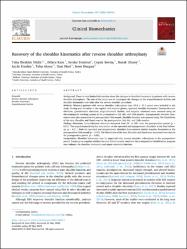| dc.contributor.author | Yıldız, Taha İbrahim | |
| dc.contributor.author | Kara, Dilara | |
| dc.contributor.author | Demirci, Serdar | |
| dc.contributor.author | Sevinç, Ceyda | |
| dc.contributor.author | Ulusoy, Burak | |
| dc.contributor.author | Eraslan, Leyla | |
| dc.contributor.author | Aksoy, Taha | |
| dc.contributor.author | Huri, Gazi | |
| dc.contributor.author | Düzgün, İrem | |
| dc.date.accessioned | 2023-09-25T12:02:46Z | |
| dc.date.available | 2023-09-25T12:02:46Z | |
| dc.date.issued | 2023 | en_US |
| dc.identifier.citation | Yildiz, T. I., Kara, D., Demirci, S., Sevinç, C., Ulusoy, B., Eraslan, L., ... & Duzgun, I. (2023). Recovery of the shoulder kinematics after reverse shoulder arthroplasty. Clinical Biomechanics, 107, 106013. | en_US |
| dc.identifier.issn | 1879-1271 | |
| dc.identifier.uri | https://dx.doi.org/10.1016/j.clinbiomech.2023.106013. | |
| dc.identifier.uri | https://hdl.handle.net/20.500.12933/1604 | |
| dc.description.abstract | Background: There is very limited information about the changes in shoulder kinematics in patients with reverse shoulder arthroplasty. The aim of the study was to investigate the changes in the scapulohumeral rhythm and shoulder kinematics over time after the reverse shoulder procedure.
Methods: Nineteen patients with reverse shoulder arthroplasty (age: 65.8 ± 10.3 years) were included to the study. During arm elevation in the sagittal and scapular planes, operated shoulder kinematics (humerothoracic elevation, glenohumeral elevation, scapulohumeral rhythm, and scapular rotations) were assessed using an electromagnetic tracking system at the postoperative 3rd, 6th, and 18th months. Asymptomatic shoulder kinematics were also assessed at the postoperative 18th month. Shoulder function was assessed using The Disabilities of the Arm Shoulder and Hand score at the postoperative 3rd, 6th, and 18th months.
Findings: Maximum humerothoracic elevation increased from 98° to 109° over the postoperative period (p = 0.01). The scapulohumeral rhythm was similar on the operated and asymptomatic shoulders at the final follow-up (p = 0.11). Both the operated and asymptomatic shoulder demonstrated similar scapular kinematics at the postoperative 18th month (p > 0.05). The Disabilities of the Arm Shoulder and Hand score decreased over time in the postoperative period (p < 0.05).
Interpretation: Shoulder kinematics may be improved after reverse shoulder arthroplasty in the postoperative period. Focusing on scapular stabilization and deltoid muscle control in the postoperative rehabilitation program may enhance the shoulder kinematics and upper extremity function. | en_US |
| dc.language.iso | eng | en_US |
| dc.publisher | UK : J. Wright | en_US |
| dc.relation.isversionof | 10.1016/j.clinbiomech.2023.106013. | en_US |
| dc.rights | info:eu-repo/semantics/embargoedAccess | en_US |
| dc.subject | Reverse Shoulder Arthroplasty | en_US |
| dc.subject | Scapulohumeral Rhythm | en_US |
| dc.subject | Shoulder Kinematics | en_US |
| dc.title | Recovery of the shoulder kinematics after reverse shoulder arthroplasty | en_US |
| dc.type | article | en_US |
| dc.authorid | 0000-0002-1779-0219 | en_US |
| dc.department | AFSÜ | en_US |
| dc.contributor.institutionauthor | Yıldız, Taha İbrahim | |
| dc.relation.journal | Clinical Biomechanics | en_US |
| dc.relation.publicationcategory | Makale - Uluslararası Hakemli Dergi - Kurum Öğretim Elemanı | en_US |
















